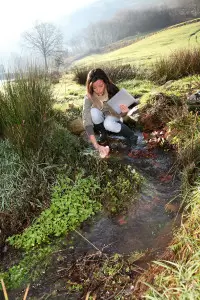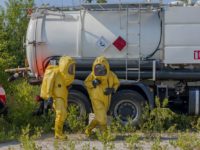
Environmental biology is similar to ecology. But while both fields study ecosystems, environmental biology places more emphasis on the biological aspect. Also, while ecology often focuses on the interactions between species in the same ecosystem, environmental biology focuses on the impacts of human activities on those ecosystems and the species living in them.
An environmental biologist investigates the impacts of actions, pollutants, and conditions on wild communities. They usually focus on ecosystems rather than a particular species. For example, they may study "indicator species" like worms that live at the bottom of rivers, lakes, and streams to assess overall ecosystem health. They may delineate wetlands areas, assess water quality, or investigate the impacts of a proposed development project.
What Does an Environmental Biologist Do?
Environmental biologists are mainly responsible for monitoring environmental conditions and conducting environmental impact assessments for development projects. These tasks usually involve significant field work, such as maintaining environmental monitoring systems and collecting water and soil samples from the field. Environmental biologists plan these monitoring and data collection programs. They must then analyze the chemical and biological data from the samples they've collected using mathematical and statistical techniques. They may use GPS equipment to record spatial information on their field activities, and geographic information systems (GIS) to create maps from the GPS data.
Environmental biologists may also determine the impacts of wastewater discharge, agricultural and urban runoff, and other conditions. Many monitor pollution levels to ensure compliance with state and federal laws. Others may conduct wetlands delineations, classify wetland types, and conduct habitat assessments. Some are in charge of consulting with government agencies and obtaining required permits for clients' development projects, or submitting official comments on proposed environmental regulations for their organizations. Nearly all environmental biologists need to write and submit technical reports detailing their findings. Their efforts help protect ecosystems from adverse effects related to human activities.
Where Does an Environmental Biologist Work?
Environmental biologists most often work for state and federal government agencies. While the U.S. Bureau of Labor Statistics (BLS) doesn't report on environmental biologists specifically, it reports that as of 2012, most environmental scientists (22%) worked in state government. Another 21% worked for companies providing management, scientific, and technical consulting services. These professionals usually help companies comply with regulations, and conduct environmental impact assessments for their development projects. 14% worked for local government agencies. 10% provided architectural and engineering services, and 7% worked for the federal government.
Environmental biologists work in offices and laboratories, but also spend a significant amount of time in the field, where they are exposed to all types of weather. Workers may also be exposed to pollutants, chemicals, and possibly water-borne pathogens while collecting samples or working with them in the lab. Following established safety precautions is important. Extensive travel to reach work sites may be required.
Most environmental scientists, including environmental biologists, work full time. They may work long or irregular hours in the field, and may need an in-state driver's license to drive government vehicles in the field.
What Is the Average Environmental Biologist Salary?
The average media salary for environmental biologists was $73,230 as of May 2020. Those working for the federal government earned the highest median salary of $103,180. Those working in engineering services earned $75,780. Environmental scientists providing management, scientific, and technical consulting services earned a median salary of $71,690. Those working for local government made $69,840, while those employed in state government made $67,700.*
Environmental Biology Jobs
An environmental biologist job may look different depending on which specific field it falls under, but generally, the biologist's focus is to study the biology of specific organisms and their interactions and examine the impact on our environment. While specific tasks do vary from job to job, environmental biologists' scope of work looks something like the list below:
- Plan and execute complex analytical biological testing following field and laboratory standard operating procedures
- Manage biological and project timelines by using testing expertise, advanced chemical and biological knowledge, and statistical tools
- Be prepared to present results to various stakeholders, both collegial and business
- Identify challenges on the project and proactively plan to overcome them
- Build professional international relationships to support the advancement of knowledge
- Ensure that equipment is maintained for quality control and assurance of lab results, and for safety purposes
Document and analyze all lab and field results, paying particular attention to calculations and observations in lab documentation - Review peers' data analyses for accuracy and scientific integrity
- Alert the project leader of unusual results and samplings and of any difficulties or problems encountered during the scope of work
At the management level, a senior environmental biologist job may have these or similar additional responsibilities:
- Apply and communicate understanding of environmental biology to business units, stakeholders, and the public
- Improve technical leadership by training colleagues and administrative support staff, as well as business partners and external customers
- Gain global recognition as a scientist with a comprehensive understanding of your field
- Communicate effectively with global and cross-disciplinary partners
- Oversee process improvements and data quality to help work group meet business and scientific benchmarks
- Create and deliver presentations to internal and external stakeholders
- Establish a leadership role in related professional activities
What Is the Job Demand for Environmental Biologists?
The job outlook for environmental scientists in general is excellent. Employment is projected to grow 8% between 2020 and 2030.* Issues like climate change and fracking have spurred more public interest in the environment. The country's aging infrastructure will also have to be replaced. These issues will likely fuel job growth.
Many of the new jobs will be in private consulting firms that help clients manage environmental concerns and comply with regulations. However, most of the jobs will still be in government and academia.
How Do I Get an Environmental Biologist Degree?
Entry-level jobs require a bachelor's degree (B.S.) in a biological, environmental, or natural science with significant coursework in biological sciences. Candidates should have an excellent foundation in biology, chemistry, ecology, and earth science. Knowledge of statistics, mathematics, and computer science is also essential for analyzing ecological data. A master's degree is preferred by some employers, and may be necessary for advancement.
Some jobs require experience with research, environmental impact assessment, or related areas, such as wetlands delineation, plant identification, or land use permitting.
Environmental Biologist - Related Degrees
What Kind of Societies and Professional Organizations Do Environmental Biologist Have?
- The National Association of Environmental Professionals (NAEP) is a multidisciplinary association for all types of environmental professionals. NAEP organizes networking opportunities, including an annual conference and regional meetings and events. It also offers webinars and hosts a career center.
- The Wildlife Society facilitates networking of wildlife professionals through magazines and journals, an e-newsletter, an annual conference, and working groups. It also administers professional certification for wildlife biologists.
*2020 US Bureau of Labor Statistics salary figures and job growth projections for environmental scientists and specialists reflect national data not school-specific information. Conditions in your area may vary. Data accessed September 2021.





